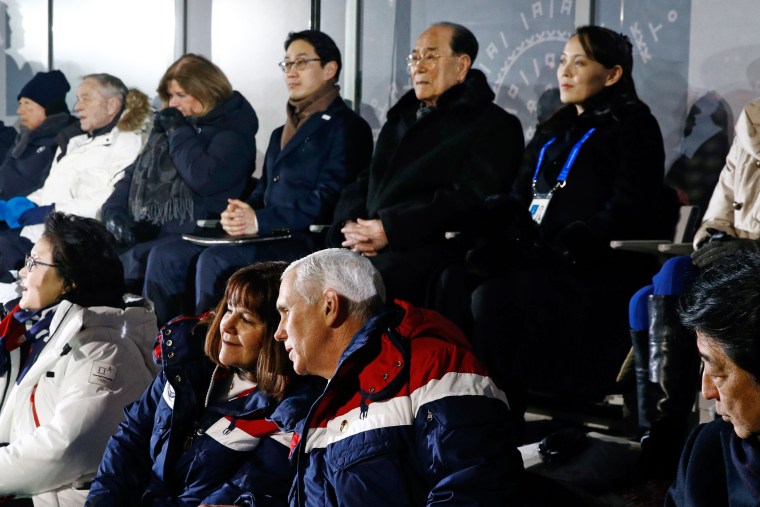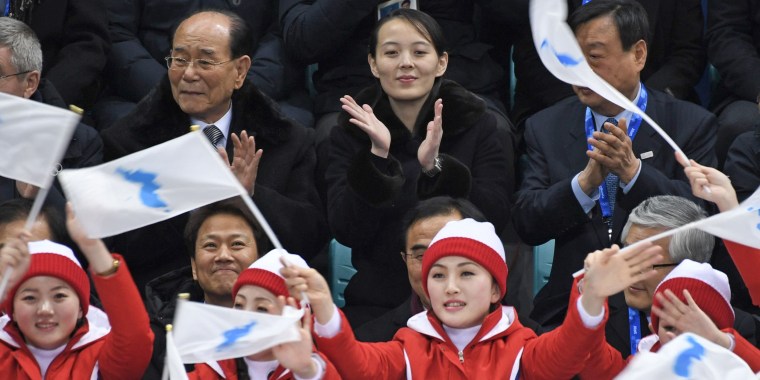Why would the South Korean government foot the bill for a North Korean propaganda campaign at the PyeongChang Winter Olympics? Certainly this question seems a valid one given the $2.64 million budget that South Korea’s Ministry of Unification designated for members of the North Korean Olympic delegation.
But with the Olympics now over, the bigger question is will the spirit of cooperation that seemed to infuse the international competition dissipate? The Western press spilled a lot of ink in the past few weeks second-guessing North Korea’s apparent olive branch, but most of this analysis has overlooked the fact that the South Korean government actively pursued and facilitated this overture.
For all the buzz surrounding the mesmerizing antics of the cheering squad, and Pyongyang’s “princess,” the clear determination of South Korean president Moon Jae-in and his administration to break the deadlock in inter-Korean relations should not be overlooked. North Korea doubtlessly ran a strong propaganda campaign, but there was also real substance to the sudden warming of relations between the rival Korean states. Since he became president, Moon has been reaching out to Pyongyang.
The determination of South Korean president Moon Jae-in and his administration to break the deadlock in inter-Korean relations should not be overlooked.
By working towards restarting dialogue with Pyongyang, Moon harkens back to the legacy of Kim Dae-jung and Roh Moo-hyun, two South Korean presidents who — between 1998 and 2008 — actively pursued a policy of rapprochement and reconciliation with the North. He does so for both pragmatic and ideological reasons. The pragmatic motivation goes well beyond the secure and safe organization of the Winter Olympics, though that was certainly a consideration.
Equally urgent is the overall security situation on the peninsula, a situation that in the months leading up to the Olympics seemed to be spiralling dangerously out of control due to the megaphone diplomacy of both the U.S. and North Korea. With both Pyongyang and Washington flexing their military muscle, Seoul knew it would be the one to feel the real punch of any shadowboxing bout. But by instead working towards opening up a channel of dialogue, Seoul will be able to influence the direction of events. And re-establishing lines of communication also means re-establishing a pressure valve, making it possible to release some of the built up tension.
Putting aside the pragmatic reasons, an important ideological motivation drives Moon: the conviction that Koreans must decide the future of Korea. Ever since the 1972 Joint Statement — the first ever inter-Korean agreement — this has been a guiding principle in inter-Korean relations. It is a principle that speaks to the historical context of the region’s division by the Great Powers in August 1945. So for Koreans to take control of their own future, they must also reclaim their history and historical agency.

In the 1980s, confrontation with North Korea had been a means for South Korea’s authoritarian state to cling to power. So doing away with the legacies of authoritarianism also lead to a fundamental questioning of this policy of confrontation. Instead, a case was made for engagement.
Meanwhile, North Korea has its own reasons to engage with its southern neighbors. For one, the United Nations sanctions are beginning to hurt. Kim Jong Un’s rule depends on a double strategy (and promise) that projects the North as a nuclear power that is also focused on raising the living standard of its people. That second aspect is going to be much harder if comprehensive sanctions continue to stifle North Korea’s economy. Reaching out to South Korea is doubtlessly motivated by an attempt to drive a wedge between Seoul and Washington D.C. — and more broadly, to weaken international support for economic penalties.
Tellingly, Kim rhetorically stuck his neck out recently by expressing a personal interest in the success of the Winter Olympics during his New Year’s speech. This sent a signal of his seeming commitment to restarting inter-Korean dialogue. One could further argue that Kim even made concessions in his attempt to participate in PyeongChang — concessions exemplified by the last-minute performances of the Samjiyon Orchestra (led by Hyon Song Wol, manager of the highly popular but ideologically motivated Moranbong Band.)
For Koreans to take control of their own future, they must also reclaim their history and historical agency.
That the visit mattered to Kim is further emphasized by the composition of the North Korean delegation that attended the Olympic opening ceremony. Previous invitations to his father, Kim Jong Il, had always faltered because of security concerns from the North. This time around, however, both the formal head of state Kim Yong Nam and Kim's own sister and close confidante Kim Yo Jong visited Seoul. North Korean media also paid the visit a lot of attention, and in their reporting, the press seemed careful to respectfully and accurately identify South Korean officials.
Back at home, the delegation reported to Kim, who then publicly commended the South Korean authorities for their warmth and hospitality. He also said the two countries should make concerted efforts to ensure inter-Korean relations are put on a more stable footing. Such comments basically confirm that Kim is in the process for the long haul. Simultaneously, a flurry of new poster designs is heralding a new phase of inter-Korean thaw to the North Korean people.
Of course, none of this changes the fact that North Korea executed a propaganda coup this Olympics. The country was given an opportunity to show a softer image to the world — and it did so. But the image of a seemingly overwhelmed North Korea head of state wiping away tears during Hyon Song Wol’s performance of a unification song is a boon to South Korea's Moon as well. Such humanizing imagery may help the South Korean president overcome both domestic and international resistance to rapprochement.
Just as during the “sunshine decade,” South Koreans have to reconnect with the North Korean people instead of focusing solely on the regime. This dynamic is exemplified in the initial South Korean reluctance a unified women’s ice hockey team. Though initially, public opinion was highly critical of depriving some of the South Korean players field time, once the team actually entered the competition the atmosphere gradually started to change. In that sense, sports diplomacy is doing its modest work: showing that despite all the political differences, North and South Korean athletes are still people.
Ultimately, Moon may have brought North Korea in from the cold, but he also knows that any further improvement in inter-Korean relations can only happen if U.S.-North Korean relations are addressed as well. The Winter Olympics created a window of opportunity and a pause to reflect. Maybe sober heads will prevail in the end. Moon certainly did his best to create the circumstances that may eventually allow that happen.
Koen De Ceuster is a lecturer in modern Korean history at Leiden University, the Netherlands. His research interests range from public history and the politics of memory in the Koreas to inter-Korean relations to art and the politics of culture in North Korea.
